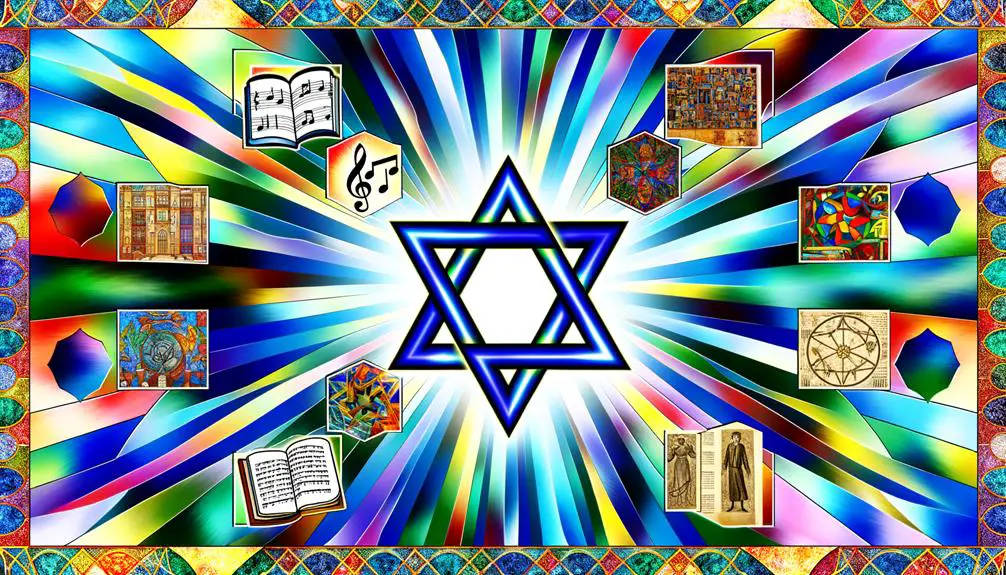What Meaning Does the Star of David Symbol Hold in Judaism?
The Star of David, or Shield of David, holds profound significance in Judaism, representing divine protection, unity, and cultural identity. Its geometric form, two interlocking triangles, symbolizes harmony between spiritual and earthly domains, and its six points signify God's omnipresence.
Historically rooted in ancient mysticism and medieval alchemy, the emblem evolved into a protective motif in Jewish tradition during the Middle Ages. Prominent in religious texts and synagogues, it is a central icon on the Israeli flag, epitomizing Jewish heritage and communal solidarity.
Exploring its historical and cultural contexts reveals the emblem's multifaceted importance.
Key Takeaways
- The Star of David symbolizes divine protection and God's presence in all directions.
- It represents the unity of the Jewish people and their spiritual beliefs.
- The emblem signifies harmony between dualities and balance of opposing forces.
- It serves as a powerful symbol of Jewish identity, heritage, and community cohesion.
- The Star of David is prominently featured in religious texts, synagogues, and the national flag of Israel.
Historical Origins
The historical origins of the Star of David, also known as the Magen David, can be traced back to ancient Jewish mysticism and medieval alchemy. This hexagram symbol has appeared in various cultures and contexts, including Kabbalistic texts where it is believed to represent the union of divine and earthly domains.
In medieval alchemy, the hexagram was used to symbolize the blending of opposites, such as fire and water. Its adoption into Jewish tradition as a protective emblem emerged in the Middle Ages, especially in the form of amulets.
The Star of David's geometric simplicity and symmetrical form have facilitated its widespread recognition and usage, ultimately solidifying its place in Jewish cultural and historical identity.
Religious Significance
Building on its historical origins, the Star of David holds profound religious significance within Judaism, symbolizing divine protection, unity, and identity. Traditionally known as the Shield of David (Magen David), its hexagram shape is often interpreted as a representation of God's omnipresence in all six directions—north, south, east, west, up, and down—thereby offering extensive protection.
It also signifies the unity of the Jewish people, both in their spiritual beliefs and communal solidarity. The emblem is frequently seen in synagogues, religious texts, and artifacts, underscoring its role as a central symbol of Jewish faith and heritage.
Serving as a visual affirmation of Jewish identity, the Star of David continues to be a potent emblem of religious and cultural significance.
Symbolic Interpretations
Exploring the Star of David through the lens of symbolic interpretations reveals a multifaceted emblem imbued with various layers of meaning beyond its religious connotations. The geometric structure of two interlocking triangles provides rich symbolism, including the dualities of existence such as male and female, spiritual and physical, and heaven and earth. This duality is often interpreted as a harmonious balance between opposing forces.
| Aspect | Symbolism | Interpretation |
|---|---|---|
| Dual Triangles | Harmony between dualities | Balance of opposing forces |
| Six Points | Six directions in space | Omnipresence and protection |
| Interlocking Shape | Connection between domains | Unity and interdependence |
| Inner Hexagon | Central spiritual core | Inner sanctity and stability |
| Historical Usage | Varied cultural significance | Evolution of meaning over time |
This layered symbolism underscores the Star of David's profound and enduring resonance.
Cultural Impact

The Star of David is an emblem deeply rooted in Jewish identity. It has greatly influenced cultural narratives across different epochs and regions. Its historical importance worldwide is intertwined with both its profound religious symbolism and its evolving modern cultural representation.
This discussion will analyze how the Star of David's multifaceted roles have shaped, and continue to shape, collective and individual identities.
Historical Significance Worldwide
Throughout history, the Star of David has evolved into a powerful emblem reflecting the cultural and religious identity of Jewish communities worldwide. Originating as a decorative motif in ancient synagogues and manuscripts, it was adopted in medieval Jewish mystical traditions as a protective symbol.
By the 19th century, it gained prominence as a symbol of Jewish identity, particularly within the Zionist movement, which sought to establish a Jewish homeland. During the Holocaust, the emblem tragically marked Jews for persecution, embedding it deeply in the collective memory.
In contemporary times, the Star of David is incorporated into the national flag of Israel, symbolizing resilience and unity. Its historical significance consequently spans a broad spectrum of cultural and societal contexts globally.
Religious Symbolism Impact
Embedded in the religious and cultural fabric of Jewish life, the Star of David serves as a potent symbol of faith, identity, and community cohesion. Its hexagram form, historically linked with divine protection and unity, transcends mere iconography.
| Aspect | Impact |
|---|---|
| Religious Identity | Reinforces Jewish beliefs and practices |
| Community Cohesion | Unifies Jewish communities worldwide |
| Cultural Heritage | Represents historical continuity |
| Spiritual Meaning | Symbolizes divine connection and protection |
| Social Recognition | Identifies Jewish presence in public spaces |
The Star of David's symbolism extends beyond the religious domain, fostering a sense of belonging and continuity among Jewish people. It encapsulates both the historical struggles and spiritual aspirations, reflecting a resilient cultural identity.
Modern Cultural Representation
In contemporary society, the Star of David manifests as a multifaceted emblem, permeating various cultural, social, and political arenas. Its modern representation can be dissected through several lenses:
- Cultural Identity: It serves as a symbol of Jewish pride and heritage, often displayed in art, fashion, and public spaces.
- Political Symbolism: The Star of David is intrinsically linked with the state of Israel, appearing on the national flag and in political discourse.
- Interfaith Dialogue: It is used in interreligious conversations to foster understanding and coexistence between different faith communities.
- Memorialization: The symbol is frequently seen in Holocaust memorials and museums, representing the collective memory and resilience of the Jewish people.
These diverse usages underscore the Star of David's enduring relevance in modern cultural contexts.
Modern Usage
The Star of David continues to hold significant cultural, religious, and political relevance in contemporary society. This hexagram is prominently featured on the national flag of Israel, symbolizing Jewish identity and heritage.
In religious contexts, it is frequently displayed in synagogues and Jewish community centers, serving as a unifying emblem for Jewish faith and tradition. Politically, it has been adopted by various Jewish organizations and movements globally, underscoring solidarity and advocacy.
Additionally, the symbol has transcended its religious roots to become an emblem of Jewish pride and resilience, particularly in the aftermath of historical adversities. Its usage spans from personal jewelry to public monuments, reflecting its enduring and multifaceted significance in modern Jewish life.
Global Perspectives

When examining the Star of David from a global perspective, it becomes evident that its cultural significance varies widely across different societies.
Religious interpretations of the symbol also differ, reflecting the diverse theological frameworks within which it is understood.
Additionally, the historical contexts in which the Star of David has been utilized contribute further to its multifaceted meanings worldwide.
Cultural Significance Worldwide
Across different cultures, the Star of David holds varied meanings and significance, reflecting a tapestry of historical and contemporary interpretations. This symbol, while primarily associated with Judaism, transcends religious boundaries and enters the world of global cultural significance. Its adoption and adaptation by different societies can be observed in various contexts:
- Historical artifacts: The Star of David appears in ancient artifacts across different civilizations, suggesting early cross-cultural exchanges.
- Modern symbolism: It is used in diverse contexts such as flags, emblems, and logos, representing unity and identity.
- Art and architecture: The symbol features prominently in global art and architectural designs, blending aesthetic and symbolic values.
- Literature and media: Its representation in literature and media often explores themes of heritage, identity, and belonging.
This multifaceted symbol encapsulates a broad spectrum of cultural narratives.
Religious Interpretations Differ
Beyond its cultural significance, the Star of David also manifests diverse religious interpretations across different faith traditions worldwide.
Within Judaism, it symbolizes divine protection and identity, often associated with King David. In Kabbalistic teachings, the intertwined triangles represent the reciprocal relationship between God and humanity.
Outside Judaism, some Christian groups regard the Star of David as a symbol of the connection between the Old and New Scriptures. In Hindu traditions, similar hexagram shapes, known as Shatkona, represent the union of male and female energies.
Islamic art occasionally incorporates the pattern for its aesthetic and geometric properties, detached from religious connotations. These varying interpretations underscore the symbol's multifaceted nature and its capacity to transcend singular religious boundaries.
Historical Contexts Vary
The Star of David's historical contexts exhibit a rich tapestry of meanings and functions across various cultures and epochs. This symbol, known as the Magen David in Hebrew, has been subject to diverse interpretations and applications, from religious to secular domains. Its historical significance can be encapsulated through the following points:
- Ancient Uses: The symbol appeared in early Jewish texts but also in non-Jewish contexts, including Hindu and Islamic art.
- Medieval Period: It gained prominence in Jewish mysticism, particularly within the Kabbalistic tradition.
- Modern Era: The Star of David was adopted as a symbol of Jewish identity and later became emblematic of the Zionist movement.
- Contemporary Usage: It now holds both religious and cultural significance, often seen in synagogues, on the Israeli flag, and as a symbol of Jewish solidarity.
Conclusion
To wrap up, the Star of David serves as a multifaceted symbol with deep historical origins, religious significance, and diverse symbolic interpretations. Its impact on culture and its modern usage reflect its enduring relevance.
How does this ancient symbol continue to shape identities and beliefs in a globalized world?
The Star of David remains a powerful emblem that transcends time, embodying both unity and complexity within various social, religious, and cultural contexts.






